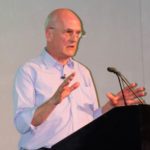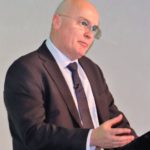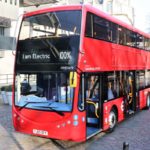Buses’ golden age?
The sixth Bus Summit looked at four key topics at what is a key time for the industry as the Bus Services Act comes in, with the pressure to act on climate change and air quality greater than ever. Stuart Jones joined the delegates at London’s Queen Elizabeth II Conference Centre in Westminster
In her keynote address, the self-proclaimed “Baroness of the Buses” began by saying: “What a transformational year this is going to be for us all. It’s the start of what I believe is going to be a golden age for buses in this country.”
Baroness Vere, Minister with Responsibility for Buses, DfT, said: “It is a privilege to speak to the people who are going to help us to shape this new era.” She said operators, local authorities and the supply chain were all equally important and were the backbone of an industry that was a driver of economic growth in cities, an antidote to rural isolation, and carried an astronomical four billion people a year. For too long, buses have been the Cinderella service: “They are dependable, reliable, but rarely in the limelight: and we can change that.”
Explaining how this would be achieved, she said: “This Government is focused on levelling up, to opening up opportunity for all and ending the sense of disconnection that exists in some communities. I see your sector as critical to achieving all of those things.” With a Prime Minister who appreciated the sector’s potential as part of a smart, sustainable, integrated public transport system, she said: “It is a great time to get excited,” but also acknowledged that there are some quite significant challenges, that passengers want more frequent buses, better value for money buses that run on time and buses that go to more places.
Breaking down the barriers that put people off getting on a bus is a real challenge
She said that discussions are sometimes too focused on existing services and existing users: “We’ve got to try and attract new ones… breaking down the barriers that put people off getting on a bus is a real challenge.”
Turning to her plans, she referenced the Better Deal for Bus Users launched last year, which included plans for the first National Bus Strategy. The aim to provide a long-term plan for sustained improvement in bus services is, she said, a complicated task that will need a lot of work. Passengers will be at the heart of it and she said that national government, local authorities and the private sector will drive it, , adding: “We all need to work together.” The “bedrock of the strategy” will be stronger partnerships between the three key players. The strategy will be supported by investment, and “real support in terms of cash money.”
Alongside the Bus Strategy there is £220m of investment. The £170m announced that morning would be invested in four schemes designed to make buses more accessible, better value for money, more efficient and greener. These cover £20m to pilot demand-responsive services in rural and suburban areas; an additional £30m for local authorities to support existing services and restore lost ones (20% of this fund would be set aside for rural authorities). There is funding (DfT website says £70m) for Superbus initiatives, though she admitted that she doesn’t know precisely what Superbus means. The example given was that operating in Cornwall, one of the poorest regions in the UK. It was designed to link up all modes. She is looking forward to seeing how it works and wants others to try it, and take up funding.
On accessibility she had set a target to make audio visual information was available on all local bus services, which she recognised was a challenge for small operators, and had set aside £2m to help them with “this absolutely vital task.” She feels the bus industry has really stepped up on accessibility.
Up to a further £50m has been allocated to “kit out Britain’s first all-electric town or city” in an unprecedented chance to see how it works. She is interested in entire life-cycle costs. She believes buses can be a key part in how we decarbonize transport.
Stressing the need to “get a hold on congestion” she said authorities and operators have new powers to identify congestion hotspots and get things moving more quickly. She said the £2.5 billion Transforming Cities Fund, is already helping, offering Leicester, Southampton and Portsmouth as examples.
Turning to the Bus Services Act she said it was “quite important that partnerships work,” and that the BSA gives a framework for operators and local authorities to take advantage of them. Praising partnership she spoke of the Bristol and York schemes.
She concluded by saying, “Let’s make 2020 the year of the Bus.”
‘More buses, better value’
Unusually, the Conference’s introductory comments were not made by Professor David Begg, but by Anthony Smith, Chief Executive of Passenger Focus, who expressed the belief that it is quite possible to create positive news about buses.
He gave details of his organisation’s newly-published report on bus passengers’ priorities for improvement, ahead of the bus passenger satisfaction surveys due in March. Current bus passengers want buses running more often, to more places, buses on time at the stop and value for money, while (in this order) non users want more destinations, more often, better value for money, bus stops nearer to home and their destination and buses running on time.
Anthony Smith, also chaired the first full session of the day, entitled ‘The investment case for the bus and why we need a bus strategy.’
‘Buses central to solution’
Laura Murdoch, Director of Bus, Accessibility and Active Travel, Transport Scotland, said that the bus is at the forefront of Scotland’s national agenda, exemplified by the First Minister announcing the 2019 programme for government sitting on a bus.
Bus is recognised as an important part of the solution to key issues including the climate emergency and poor air quality, inclusive economic growth, providing better connectivity from remote rural areas and supporting efforts to promote more active travel.
There have been significant developments in Scotland in the last year. The Transport Scotland Act was passed, including measures to roll out low emissions zones in cities, new powers for workplace parking levies, changes to the regulation of bus services. Scotland had taken a very different approach on local authority powers, giving them extensive new powers to run their own bus services or to create or acquire their own bus companies.
“In practice though, we see the partnership provisions as the most popular way forward,” she said, “giving powers to local authorities and our Regional Transport Partnerships to work with operators, users and others to create binding, outcome-focused, partnerships.” They had looked at partnership working in the West Midlands and Leeds among other places and had been impressed with what they had seen.
Also announced last year was unprecedented bus funding of more than £500m to tackle the negative impact of congestion on bus services. With the Bus Partnership Fund, Transport Scotland is, she said: “…looking for evidence of effective partnership working between authorities and bus operators, including wider commitments from both to improve the bus offer for existing bus users and to attract new ones.”
On emissions, the Parliament had set world-leading statutory air quality targets backed by retrofit funding to bring older buses up to Euro VI. They were working with operators to develop a multi-year transition to a fully zero-emission fleet.
The long term fundamental nature of what they are trying to achieve, and the cross cutting issues faced demand a strategic approach. The day before the conference, Scotland’s 20-year National Transport Strategy had been published setting out a vision for transport. The four priorities behind it are; taking climate action, reducing inequalities, helping develop inclusive economic growth and improving health and wellbeing. “Bus delivers big on all four of those outcomes,” Laura said. The document sets out new transport and investment hierarchies making clear that public transport is at the heart of what they are trying to achieve. An action plan specific to bus is under consideration and will follow consultation with all parties.
Laura Murdoch is interested to see the actions and offers made in England through CPT’s ‘Moving Forward Together’ document and to see what Scottish operators can commit to in response to the new investment ahead.
Laura was clear that there is now “unprecedented engagement from the highest level of Scottish government.”
‘Congestion ignored’
Encouraged the Government having promised a National Bus Strategy, something David Brown, Chief Executive, Go-Ahead, had called for at the previous year’s Bus Summit, and by what he had heard Baroness Vere say, David chose to focus on congestion, the role of the bus in tackling congestion and local authorities in enabling buses to reduce congestion.
You cannot get people stuck in traffic in cars out of them and on to buses if the bus is also stuck in traffic, he said. He noted that a 10% drop in the average speed of a bus in service results in a 10% loss of passengers. Congestion has got so bad that Oxford’s X90 service could no longer be run viably, and routes in East Anglia had had to be curtailed. He also noted that below 5mph, emissions from Euro VI buses double.
Congestion is at the heart of everything on the Conference agenda. If congestion isn’t tackled, you can’t effectively tackle emissions; neither could you support town centre retail if passengers have abandoned buses because they took too long. And if congestion isn’t tackled, there won’t be any commercial services left for the Bus Services Act to regulate.
It amazed him that the introduction of the Congestion Charge in London was in 2003, yet the scheme has never been replicated anywhere else in the UK. The assumption appears to be that you could never bring the public with you, and to attempt it would be (in the words of Yes Minister’s Sir Humphrey Appleby) ‘Courageous Minister.’ In Manchester, where the consultation on franchising is underway, he said: “There is not a single acknowledgement of the need to tackle the horrendous congestion in that city, because that is the only thing that will effect modal shift and grow passenger volumes.”
Widespread personal vehicle ownership does not appear to be compatible with significant decarbonisation
He observed that now, in 2020, there are serious changes afoot across society. How the Government is to achieve net-zero by 2050 is affecting all strands of policy from agriculture to taxation. This will affect everyone he said, mentioning pension funds that will no longer invest in gas and oil, only renewables, and the chief of Unilever saying that any lines that aren’t sustainable, even if profitable, will be dropped. At a local level, courageous steps are being taken. York plans to ban cars from the city centre. The public mood is changing, often before legislators realise it. Other cities including Birmingham, Oxford, and Brighton are also look at curtailing car use.
David said: “We need to be concerned if the new drive is all about electric.” He pointed out that (according to the International Energy Agency) every new electric car hits the road with a huge carbon deficit and only starts saving on emissions once it has done 40,000 miles, so if people are using them as second cars, as many are, they are not helping. The Commons Science and Technology Committee has concluded that ‘widespread personal vehicle ownership does not appear to be compatible with significant decarbonisation.’ He also pointed out that electric cars are still cars, and create congestion.
He doesn’t see the bus strategy being about more legislation, and much of it wouldn’t be about more money (welcome though that was): “It was about seizing the moment on climate change and air quality and putting in place a national framework that will drive the right behaviours. Local authorities need to be encouraged to use the powers they already have to tackle congestion and to work with operators to get more people to use the bus.”
He was clear: “Any strategy that does not tackle congestion won’t achieve modal shift.”
‘Single framework will deliver’
At his first Bus Summit, Graham Vidler, Chief Executive of the Confederation of Passenger Transport, said that, in CPT’s opinion: “the National Bus Strategy needs to deliver a single framework that everyone involved in bus; operators, suppliers, local authorities and all parts of Central Government, can follow.”
Ahead of the strategy, the industry’s players have already set out their own plan to improve bus services. This includes making every bus bought from 2025 an ultra-low or zero-emission bus; reducing CO2 emissions by 500,000 tonnes a year; rolling out price-capped, contactless, multi-operator ticketing in urban areas by 2022; and offering a national approach to expand discounted ticketing to apprentices and job seekers.
Some people, quite rationally, used their car when they could use the bus and over the past five years increasing congestion levels has led to 160m fewer bus journeys being made.
He thought it was great to hear the minister put congestion right at the heart of the National Bus Strategy and said CPT needs to make sure this was followed through: “If we get it right and we can reverse the vicious cycle of congestion, it will bring huge benefits to passengers and wider communities.”
Taking Dudley, the largest town in the UK without a rail station in its town centre, he showed a graphic illustrating how far you can get from the town on the bus in the morning peak. This does not include Birmingham, ten miles away, that takes 80 minutes, though only 50 in the afternoon peak. Not only is this limiting the people of Dudley’s ability to apply for jobs and training opportunities, it is limiting the pool of labour on which Birmingham can draw. He said there are 1,000 ‘Dudleys’ and they all deserve better, faster bus links.
Among other advantages of the bus he pointed out were that people who travel by bus walk more and those who switch to bus experience a significant reduction in Body Mass Index (BMI). He also noted that the latest diesel buses emit less per vehicle than a new diesel car.
Quoting Government figures, Graham said that 68% of people now think congestion is a serious problem in towns and cities, up from only 39% a decade ago. 74% think that people should use cars less, and only 10% do not. In the light of this, he thinks politicians have a once-in-a-generation opportunity to capture and act on the public’s recognition of the growing need to do something about congestion.
Closing he said: “2020 is a transformational year for bus, but for this year to really bring benefits for the people and communities that depend on buses we need to see that Transport Strategy really get to grips with congestion. I hope and believe the Strategy will seize the moment. If it does, we won’t be talking of 2020 as the year of the bus, we’ll be talking about the 2020s as the Decade of the Bus.”
‘I gave up my car’
Lilian Greenwood, MP for Nottingham South and the former head of the Commons Transport Select Committee, gave up her car a year ago, so she ‘walks the walk.’
She said that efforts to get buses on to the political agenda are succeeding, and there are really good reasons why they should. She believes buses have got to be part of achieving the target of net zero carbonby 2050. People want to get out of their cars, but there has to be the right offer that enables them to do that. Communities designed around the bus are “more liveable” she said: indeed, for some people, getting on a bus was a means in itself and tackles isolation: “In short, Buses – what’s not to like?” she said.
She had been part of the Select Committee’s report into the bus industry which tried to better understand how the bus market is operating: to explore the challenges that operators and local authorities face in maintaining and improving services and to gather ideas for how policy could be changed to tackle those challenges and encourage greater bus use. The committee also wanted to make sure that the public money that goes into supporting the bus market (which represents about 42% of revenue to operators) is spent effectively.
The Transport Act 1986 hasn’t delivered the lower fares and better services that were claimed
She claimed that the Committee learned that the Transport Act 1986 “certainly hadn’t delivered the lower fares and better services that were claimed would result from removing the dead hand of regulation.” Subsequent Governments have legislated for new bus operating models, most recently in the Bus Services Act, but some models had never been used at all. Not all were available to local authorities on the same basis.
Lilian said: “The lack of funding was highlighted by everyone and there was dissatisfaction, not just about the level of funding but the way in which funding came forward. Whether it was BSOG, Grant funding or concessionary fares reimbursement, nobody was really happy with how things worked.
“I think we all welcome the extra funding that was announced today, but we know that bid for funding has its drawbacks, as it was one of the things we heard.” Looking at the Nottingham perspective, she said that Nottingham is very good at bidding for funding: “Other places were not so good and one of the worries the Committee had was because they were successful, some places continued to be successful, whereas some places that haven’t got that history find it more difficult to access it and effect change in their local area.”
After hearing the evidence, the Committee’s recommendations were: giving all local authorities equal access to the powers they need to improve bus services in their areas; a need for more stable multi-year funding from Government and a need to reform BSOG and the funding of concessionary fares reimbursement. The Committee thought there was also an urgent need to review the funding of socially necessary services by local authorities.
It called for targets for modal shift and action to meet those targets, with examples of what works. It wanted more guidance and sharing of evidence on bus priority measures, better information for passengers and potential passengers and simpler ticketing and fares. Better working together between planners and public transport planners were needed to make sure that their priorities aligned. Finally it recommended that it was all brought together within a National Bus Strategy before the end of 2020.
She concluded: “This Government’s decision to publish a bus strategy is a really important decision – I just hope it lives up to the rhetoric. The Transport Committee will be scrutinising Government and asking questions to make sure that it does.”
What is the role of the bus is achieving clean growth and net zero?
Referencing the forthcoming COP26 climate conference in Glasgow in November, Claire Haigh, CEO, Greener Journeys, said the UK has a major role to play in agreeing the agenda for the world’s future. She said: “The UK urgently needs a credible plan. The plans are significantly off-track and nowhere is this more the case than in transport, the only sector to have increased its footprint over the last plan, though this is mainly down to cars and vans.”
Claire believes the bus must be at the heart of decarbonisation and clean-air strategies, leading the way on the ‘road to zero.’ Progress on greening the bus fleet outstrips that with the car fleet by a margin. She also pointed out that 80% of buses operated in the UK are built in the UK, whereas the figure for cars is around 13%.
Saying that the Bus Strategy needs to maximise the use of bus and maximise decarbonisation, she warned that the key challenges are political not technological: “We need to break the dominance of the car. We mustn’t fall into the trap of thinking electric cars are a panacea.
“The signs are that radical measures are becoming more politically acceptable,” she claimed. In conclusion Claire said that, in launching COP26, the Prime Minister personally intends to ensure that the UK is in the vanguard on climate change. He is committed to buses and, “a massive investment in electric buses should be at the heart of the Strategy.”
‘Scale of the challenge is awesome’
Gareth Powell, MD of Surface Transport, Transport for London, said that TfL has achieved 11% modal shift from car since 2001. Supported by slides, Gareth’s presentation looked at how London will grow, what this means for TfL and how the fleet will meet its environmental responsibilities. Today the city’s population is 8.6m, by 2030 it is expected to have risen to around 10m.
He reviewed the ULEZ introduced last year, the extension of the LEZ this year and next year’s extension of the ULEZ showing that by 2025 the benefits would mean there were no primary or secondary schools in areas that exceeded legal air quality limits, only 2% of roads would exceed NO2 value limits and the gap in air quality between the city’s highest and lowest income areas will be reduced by 71%. He also reviewed low emission bus zones and talked of the bus retrofit programme that will see the entire fleet reach at least Euro VI equivalent level his year.
TfL’s fleet of buses, trains and trams is responsible for 13% of all transport carbon in London and the scale of the challenge to take it to zero emissions is awesome, he said. As another slide showed, 9,350 buses will need to be electrified, 6,300 garage chargers installed, 750 new stabling locations found, 76 garages upgraded and 12 sub-stations upgraded. By 2037 the bus fleet will consume 700Gwh annually.
“Growth is coming and that needs to be sustainable and green,” Gareth concluded.
‘Bus alliance a success’
Councillor Liam Robinson, Transport Portfolio Holder, Liverpool City Region Combined Authority said that, “We have one of the strongest success stories anywhere in this country on bus. The bus is the underpinning of our economy, with 147m bus passenger journeys a year within the LCR region.”
He was proud to say that, through the Bus Alliance with major operators, LCR had been able to arrest the decline in passenger numbers. Measures taken had included smart traffic light technology, 100% contactless ticketing availability, collective marketing campaigns, and over £40m in new buses.
Next would come green bus corridors which were the start of a BRT network, plans for which would be unveiled later this year. There would be some re-routing in the city centre with some roads shutting. The Mayor wanted an all-zero-emission fleet by 2035, which would require depots locating near to power supplies. An order had been placed for 25 hydrogen buses that will use hydrogen that was currently a waste product produced locally at Ellesmere Port.
Liam said the LCRCA is “more than happy to be part of the procurement process for a new fleet of buses.” He believed the Government needed to support bus manufacturers to stay ahead in world markets.
‘Politicians have failed us’
Pulling no punches, Mark Fowles, MD, Nottingham City Transport, said the industry had delivered for the last 20 years and most of the failings had been down to politicians.
He contended: “Cities have been declining for years and we’ve done bugger all about it. Cities have to be designed for public transport and the people who live in them. Integration isn’t just about buses meeting trains; it’s the way we live our lives.”
Cities had planned for congestion with ever narrower roads on estates, some so narrow that services could not be run in the evenings because you can’t get through for parked cars. There are also a lot of industrial estates that can only be accessed by car. It isn’t only the cities; the latest generation Azuma trains are more difficult to get on and off than their predecessors.
Integration isn’t just about buses meeting trains; it’s the way we live our lives
In 1997, Nottingham had 400m of bus lanes but today it has over 24km. The lanes upset people because they say there is nothing in them: “There’s a reason, it’s because they are bloody working and if there was something in them they wouldn’t work.” Because of the measures taken, Nottingham has had ten years of zero congestion growth.
On the question of the buses’ role in achieving net zero he was clear: “The bus is the facilitator, the executor, the deliverer. It is not the carrot, it is not the stick, that responsibility lies firmly with the politicians who have to be brave.”
‘Drivers could get 40% more range’
Robert Drewery, Commercial Director, Optare thinks battery electric buses are the future for urban bus applications with the possibility of hydrogen range extenders having a role in rural areas and places with a need for air conditioning. This year 15% of all buses delivered in the UK will be zero emission and by 2023 he anticipates it will be 60% of what Optare sells.
He accepts that electric buses are expensive to buy and there is the additional spectre of mid-life battery replacement costs. It represents a big culture change for operators, and planning routes and drivers to get the most out of them is difficult. Range has a massive effect on the economies of operation, he said, and buses should reach 200 miles reliably within the next couple of years. Driving style can make a 40% difference in power consumption.
Buses, Business & Retail
Chaired by Transport Focus’s Senior Stakeholder Manager, Linda McCord, who also chairs the West Midlands Bus Alliance, this session had a different format to the others consisting of very short presentations by each panelist followed by a series of questions to which each person contributed their view.
Tom Thackray, Director of Infrastructure & Energy, CBI.
Tom said that more and better bus journeys were good for business and a key factor in developing good places to work. The CBI was inundated with businesses wanting to become more ecologically sustainable. He noted that too much time was being spent in congestion and also that in the last decade wages had gone up 23% while fares had risen by 60%.
Jane Gratton, Head of People Policy, British Chambers of Commerce.
Chambers were working to create conditions for local economic growth and the bus had a vital part to play in connecting in connecting employers to skills and talent and apprentices to education and employment opportunities, as well as creating a vibrant day/night economy. Only a third of businesses said the road network met their needs
Ojay McDonald, Chief Executive, Association of Town & City Management.
Ojay commented that in 1952 a car had cost four years’ wages, now it was around 18 months. Most city centres pre-dated major car ownership, and most cars spent 95% of their time parked, yet needed a parking place when they did go to town. Describing the bus as “the best friend we never knew we had,” he said the Association was looking at Smart payment technology to see how it could use services to nudge people into using the bus.
Lynn Cramman, Business Development Manager, Cobalt Park.
Lynn took the decision to work with local authorities and operators to develop transport links to Cobalt Park, an out of town site that now employs 14,000 and is still developing. She noted the important of long-termism saying that it had taken seven years for one of the services to become commercial.
David Tucker, Chair, Federation of Small Businesses Transport Policy Unit
David’s perception of why the bus doesn’t work in his experience lies in his living in a small village in Devon. There was a lack of rural provision and he believed there should be more funding and joined up thinking. He wanted to see the industry move away from big vehicles to smaller ones that were more demand responsive.
Making the most of the Bus Services Act
As one of the key architects of the Act, Stephen Fidler, Director of Local Transport at the Department for Transport was ideally placed to chair this session.
Gerard Whelan, Director, Corporate Finance, Government & Infrastructure, KPMG.
Gerard referred to a report (still available on the KPMG website) of five years ago, that he had worked on, into the pros and cons of different interventions in the market saying that the situation had changed since then. Civic leaders now needed to provide considerably more support for public transport because if they were serious about climate targets, improving the attractiveness of local bus services was arguably the quickest, cheapest way to make a difference. The productivity gap between the best and worst regional areas was the widest it had been for half a century and there was a need to unblock sites to provide additional housing.
Gerard said, “If funding is available, I think that the industry needs to look at the options for delivery. As the Act recognises, there’s not a one size fits all approach, it very much depends on local circumstances. Those that wish to make use of the Act to deliver changes, need to do four things, in his opinion. Firstly they needed to describe how bus services will contribute to local imperatives, to meeting clean air targets and national targets, reducing highway congestion and unlocking the benefits of new housing. Second, they need to consider investment in local bus infrastructure within a broad transport policy context, including reallocation of highway capacity and potentially, demand management measures. These were tough decisions. Thirdly, we need to develop better partnership working between local authorities, developers and bus operators in a broader sense to explore the options for delivering new services. Finally providing stakeholders with great certainty to develop the network by committing to longer term capital and revenue funding, is important.
Although the Act gave the powers needed, without new resources, in expertise as well as funding, the ability to deliver was limited.
In his opinion, “the Bus Services Act is the biggest single game changer for the sector and we must embrace it.”
Mark Threapleton, Chief Operations Officer, Stagecoach.
Tackling the question, Mark said, “How can we make the most of the Act when we are shackled by an issue that is so enormous that it has been and still is constraining the efficiency and effectiveness of local economies and the bus industry that is the heartbeat of those economies.” Recent Transport Focus research showed that the top priorities for passengers had not changed. They were reliability, punctuality and value for money and there was a distinct link between reliability and punctuality and customers” perception of value for money. “The biggest issue constraining us today that prevents us being able to meet these customer priorities is congestion… It is the biggest issue our customers face and still one that has gone largely unaddressed.”
“Congestion created a cycle of higher operating costs which are passed on to the customer in longer journeys, less journeys and higher fares. It isn’t a great customer proposition,” he said, adding, “bus journey times are increasing, be in no doubt.” It now takes 87% longer to get between Cheltenham and Gloucester than only a decade ago.
Even London, rightly held up as the benchmark, has struggled to combat decline in journey speeds. They are experiencing greater journey time variability and the resulting downward pressure on passenger trips. This tells us that the regulatory model makes little if any difference.
Mark believed the industry already had the necessary regulatory tools the industry needs to survive, modernize and prosper in the changing marketplace for travel. Stating the “blindingly obvious” he reiterated that he was not a fan of franchising, but for the bus to remain relevant to consumers, “we urgently need the collective determination to make the legislation and its various regulatory models work. We need to prioritise the efforts and energies of all stakeholders to address the issues that really matter to the customers and the communities we serve, and that means tackling congestion.”
“If we can’t address the fundamental issues of punctuality and reliability everything we are trying to do to drive modal shift and modernize our bus proposition will fall short of our objectives.”
“The size of the prize is enormous and with Government and public attitudes all starting to align, now is the time to use the legislation we have to really make a difference. There is a wider understanding and appreciation of the impact of individual travel choices and the damage to health, the environment and the economy caused by nose to tail traffic,” he said.
Mark thought there were flaws in the Act regarding partnerships in terms of the management of risk. They were too prescriptive and this was why he thought there had been little interest in using these provisions from operators and local authorities.
He expressed concern that every meeting he went to with local authorities was taken up with discussions around franchising with congestion barely mentioned.
He believed “operators should be held to account, but so should local authorities for providing the environment to increase bus use. “Bluntly, this means tackling congestion,” he said.
He concluded that the Act, “gives us the tools – what is missing is the willingness to make it work.” It had to, “be about a lot more than bus regulation and control. It must be about congestion, and if it isn’t the Act will have failed.”
Simon Jeffrey, Policy Officer, Centre for Cities.
Simon said the Centre for Cities were massive fans of buses and what they do for cities. He was strongly pro-franchising because incentives matter for politicians when making unpopular decisions on issues such as car parking and congestion charging. It would help Mayors in their plans to support business and housing development knowing that the buses would be there.
There was a need to create TfL style organisations which he did not see as an extra cost because it was important to have high quality local institutions.
He did not think enhanced partnerships would encourage competition, rather that they would entrench existing operators. He thought that franchising maintained competition throughout the life of a contract rather than for the short term that most commercial competition usually lasted.
Simon said, “We really think that franchising, by bringing all of this into the local authority, is going to deal with some of those incentives to tackle congestion, to tackle the under-supply of subsidies. Incentives really do matter, the fact that Edinburgh was leading the way on Greenways, the fact that Nottingham has done the workplace parking levy, there is a clear link between being able to know exactly what the outcome is going to be and be able to know clearly, without some element of risk in your partner, what you are going to achieve, that is going to be really useful in tackling congestion that is probably the biggest thing pushing people off the buses.”
He believed all cities should have the option to go for franchising.
Pete Ferguson, CEO, Prospective
Pete”s concern was with the use of data to inform decisions. He said operators and local authorities now have access to an enormous bank of data on network congestion, origin-destination flows, travel and dwell times, and asked, “How can partnerships make the most of transit data?”
Prospective was creating a digital twin of every city in the UK to predict transport demand and where the bus sits within the framework.
He warned, “Many things will have to be done incrementally” and explained the four stages his company went through the to utilise the available data. To begin with bus data was integrated into a multi-modal picture of the transport system. They then projected how demand will shift between modes before mapping where demand will enter and exit the bus network. After this the service design was adjusted to realise the benefit of capital investment.
He came up with a list of recommendations for partnership engagement. The three points were: Bus operators and planning teams need to measure how interventions interact with the wider transport network using data to inform scheme design. Better use of data will lead to better, bolder schemes coming forward. Secondly, this kind of integrated impact assessment needs to become more tactical – part of the day-to-day activities of operational staff rather than remaining the obligation of strategic planning. Finally, partnerships need to not just use data to agree service agreements around investment schemes but to use data to collectively advocate for the wider benefits of bus on citizen outcomes.
Concluding, he said, “the best schemes that come forward will be those grounded in the best evidence.”
Question time
A useful question and answer session followed, starting with the issue of, “How do you get some leadership and recognition of the common problem.”
Mark said he would like to galvanise people’s energies to tackle the problem. Too often these were sidetracked on to issues of governance which wasn”t tackling the problem. Simon said, “Leadership needs to be in the hands of those with the fire in them to achieve it and control of the levers.” Gerard thought the time was right for civic leaders to put the focus on public transport, adding that what was needed was not just capital expenditure but investment in the people skills to enable them to make the right decisions. On this point Mark said they were still quite a way from having all these skills but a lot nearer than five years ago.
Hugh Jaeger, a Trustee of Bus Users, said, “Who in their right mind would think franchising, a beauty contest every five years, can be the right way to run a business that needs to work on a permanent basis. Where is the advantage?” Simon conceded, “it’s a risk.”
Picking up on a point that Chris Cheek had made earlier in the day about a 1% modal shift from car requiring a 17% increase in public transport, Transport Consultant, Stephen Joseph, said that, in the light of the climate emergency, “maybe we need a 300% shift in bus usage and need a completely different sort of approach for buses.” He mentioned the Friends of the Earth”s call for road pricing with the money raised going back into public transport.
Chris Cheek made three observations. Firstly that if we are going to invest a large amount of capital that has a cost, and local politicians don”t always recognise the cost of profit. Secondly that there should not be so much signing up to grand designs. Everyone signs up to them but it falls down on implementation at a granular level. Finally, he said a new source of funding was needed for Local Government. “We can”t expect them to deliver an agenda with huge challenges on social welfare funding because it can”t stretch to finance it. It has to be a new revenue source.” Mark Threapleton said that “Five year change is not commensurate with the investment costs we are going to have to make to deliver.”
A transport planner in the audience claimed that the benefits of orbital investment were a key point in favour of franchising.
Closing the conference Stephen Fidler highlighted the announcements made earlier in the day by the DfT and what they might mean for the sector. He was particularly interested in what people”s response to the Superbus proposition was?
Exhibition
Alongside the Conference there was a trade exhibition with 15 exhibitors, including: Optare, Scania, Blink,
Portsmouth City Council, Prospective, Podaris, 21st Century, Low CVP, Transaid, CPT, Alzhimer”s Society, CitySwift, the Department for Transport and Transport Times.
Outside three double deck buses were displayed. These were an Alexander Dennis BYD Enviro400EV City in TfL livery; a CNG-fuelled Scania NUB250 ADL Enviro400 City for First”s Bristol operation and an Optare MetroDekka electric bus for Metroline.
Last word
Having attended most previous Bus Summits, it was odd not to see Professor Begg, who was present, on stage mediating in any of the sessions and asking thought provoking questions at the end of presentations.
Amazingly, given that it is the issue of paramount importance to most independents currently, the one that is losing them sleep, and one that threatens the future of school transport provision, with significant cost implications for local authorities, I did not hear a single direct mention of PSVAR.
After listening to a thought-provoking and wide ranging line-up of speakers, the message I got was that the issue is congestion, congestion, congestion. Yes, there are low emission infrastructure issues that can be resolved in time, but focusing on congestion is at the root of everything that needs doing, and has needed doing for years. Anything else is just wasting time and energy.















